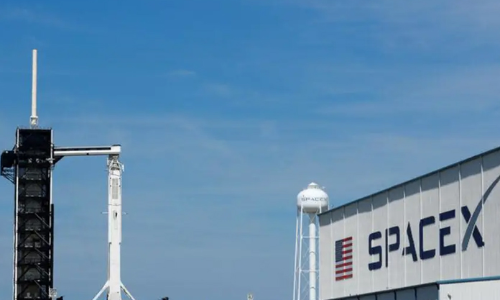Live
- Revolutionizing Customer Service: Enhancing Customer Experience through OneConnect Project and SAP Service Cloud
- Delhi govt to implement work from home for 50 pc govt staff amid severe air pollution
- Annual addition to green energy capacity likely to surpass 35 GW: Report
- Seeking to complete 1st nuclear power plant as scheduled: Egyptian PM Madbouly
- Priyanka Chopra shares heartwarming moment of Malti enjoying Autumn
- "We play with passion and pride', says captain Durga Rao after India pulls out of Blind T20 World Cup
- Rural India’s women entrepreneurs: Stories of grit and success
- On World Fisheries Day, new schemes to be launched to push growth
- Serena Williams pays touching tribute to Rafa, says 'choked up with Nadal's retiement'
- Realme GT 7 Pro Launch: Snapdragon 8 Elite Chip, Smaller Battery, and Premium Features
Just In
Elon Musk\'s SpaceX capsule splashes down off Florida coast


An unmanned capsule from Elon Musks SpaceX splashed into the Atlantic Ocean on Friday, successfully completing a mission crucial to NASAs longdelayed quest to resume human space flight from US soil later this year
An unmanned capsule from Elon Musk’s SpaceX splashed into the Atlantic Ocean on Friday, successfully completing a mission crucial to NASA’s long-delayed quest to resume human space flight from US soil later this year.
After a six-day mission to the International Space Station, Crew Dragon detached at about 2:30 a.m EST (0730 GMT) and sped back to earth, reaching hypersonic speeds before an 8:45 a.m. EST (1345 GMT) splash-down about 200 miles (320 km) off the Florida coast.
A SpaceX rocket launched the 16-foot-tall (4.9-meter) capsule from the Kennedy Space Center in Florida last Saturday.
“Everything happened just perfectly, right on time the way that we expected it to,” Benjamin Reed, SpaceX’s director of crew mission management, said in a live stream from California.
It was a crucial milestone in the US National Aeronautics and Space Administration’s Commercial Crew Program ahead of SpaceX’s first crewed test flight slated to launch in July with US astronauts Doug Hurley and Bob Behnken.
“This really is an American achievement that spans many generations of NASA administrators and over a decade of work,” said current Administrator Jim Bridenstine.
Steve Stich, the crew program’s deputy manager with NASA, said the vehicle was doing well after the splash-down.
The capsule, which was lifted out of the water by a boat using a crane, is due back on land by Sunday. The live stream showed its protective shell had been weathered from intense heat during re-entry.
The mission carried 400 pounds (180 kg) of test equipment to the space station, including a dummy named Ripley outfitted with sensors around its head, neck, and spine to monitor how a flight would feel for a human.
The space station’s three-member crew greeted the capsule last Sunday, with US astronaut Anne McClain and Canadian astronaut David Saint-Jacques entering Crew Dragon’s cabin to carry out air quality tests and inspections.
An unmanned capsule of the SpaceX Crew Dragon spacecraft is seen shortly after splashing down into the Atlantic Ocean as SpaceX recovery teams work on it, in this still image from video from NASA Commercial Crew, in the Atlantic, about 200 miles off the Florida coast, US, March 8, 2019. Courtesy NASA/Handout via REUTERS
NASA has awarded SpaceX and Boeing Co a total of USD 6.8 billion to build competing for rocket and capsule systems to launch astronauts into orbit from American soil, something not possible since the US Space Shuttle was retired from service in 2011.
Results from this mission will determine whether SpaceX can stick to its current 2019 test schedule following previous development delays for the Hawthorne, California-based company and Boeing.
“I don’t think we saw really anything in the mission so far - we’ve got to do the data reviews - that would preclude us from having a crewed mission later this year,” Stich said.
The launch systems are aimed at ending US reliance on Russian Soyuz rockets for USD 80 million-per-seat rides to the USD 100 billion orbital research laboratory, which flies about 250 miles (400 km) above the earth.
NASA resumed talks with Russia’s space agency Roscosmos in February seeking two additional Soyuz seats for 2020 to maintain a US presence on the space station.
The short-notice solicitation, posted on Feb. 13, “provides flexibility and back-up capability” as the companies build their rocket-and-capsule launch systems.
Boeing’s Starliner crew capsule is poised to launch its maiden unmanned mission in April ahead of an August test flight carrying US astronauts Michael Fincke, Chris Ferguson, and Nicole Mann.
Bridenstine told Reuters the cost per seat on the Boeing or SpaceX systems would be lower than for the shuttle or Soyuz.
Privately owned SpaceX, also known as Space Exploration Technologies Corp, was founded in 2002 by Musk, who is also a co-founder of electric car maker Tesla Inc.

© 2024 Hyderabad Media House Limited/The Hans India. All rights reserved. Powered by hocalwire.com






